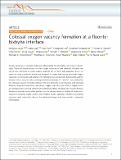| dc.contributor.author | Sun, Lixin | |
| dc.contributor.author | Lu, Qiyang | |
| dc.contributor.author | Yildiz, Bilge | |
| dc.date.accessioned | 2020-08-24T15:53:16Z | |
| dc.date.available | 2020-08-24T15:53:16Z | |
| dc.date.issued | 2020-03 | |
| dc.date.submitted | 2019-08 | |
| dc.identifier.issn | 2041-1723 | |
| dc.identifier.uri | https://hdl.handle.net/1721.1/126752 | |
| dc.description.abstract | Oxygen vacancies in complex oxides are indispensable for information and energy technologies. There are several means to create oxygen vacancies in bulk materials. However, the use of ionic interfaces to create oxygen vacancies has not been fully explored. Herein, we report an oxide nanobrush architecture designed to create high-density interfacial oxygen vacancies. An atomically well-defined (111) heterointerface between the fluorite CeO2 and the bixbyite Y2O3 is found to induce a charge modulation between Y3+ and Ce4+ ions enabled by the chemical valence mismatch between the two elements. Local structure and chemical analyses, along with theoretical calculations, suggest that more than 10% of oxygen atoms are spontaneously removed without deteriorating the lattice structure. Our fluorite–bixbyite nanobrush provides an excellent platform for the rational design of interfacial oxide architectures to precisely create, control, and transport oxygen vacancies critical for developing ionotronic and memristive devices for advanced energy and neuromorphic computing technologies. | en_US |
| dc.description.sponsorship | United States. Department of Energy. Office of Science User Facility (Contract DE-AC02-05CH11231) | en_US |
| dc.description.sponsorship | United States. Department of Energy. Office of Science (Contract DE-AC02-06CH11357) | en_US |
| dc.language.iso | en | |
| dc.publisher | Springer Science and Business Media LLC | en_US |
| dc.relation.isversionof | 10.1038/S41467-020-15153-8 | en_US |
| dc.rights | Creative Commons Attribution 4.0 International license | en_US |
| dc.rights.uri | https://creativecommons.org/licenses/by/4.0/ | en_US |
| dc.source | Nature | en_US |
| dc.title | Colossal oxygen vacancy formation at a fluorite-bixbyite interface | en_US |
| dc.type | Article | en_US |
| dc.identifier.citation | Lee, Dongkyu et al. “Colossal oxygen vacancy formation at a fluorite-bixbyite interface.” Nature Communications, 11, 1 (March 2020): 1371 © 2020 The Author(s) | en_US |
| dc.contributor.department | Massachusetts Institute of Technology. Laboratory for Electrochemical Interfaces | en_US |
| dc.contributor.department | Massachusetts Institute of Technology. Department of Materials Science and Engineering | en_US |
| dc.relation.journal | Nature Communications | en_US |
| dc.eprint.version | Final published version | en_US |
| dc.type.uri | http://purl.org/eprint/type/JournalArticle | en_US |
| eprint.status | http://purl.org/eprint/status/PeerReviewed | en_US |
| dc.date.updated | 2020-08-21T13:21:08Z | |
| dspace.date.submission | 2020-08-21T13:21:10Z | |
| mit.journal.volume | 11 | en_US |
| mit.journal.issue | 1 | en_US |
| mit.metadata.status | Complete | |
